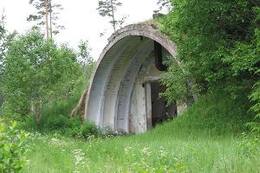Incense and Rohu missile base
In the city of Rakvere, on Arkna Road in the 1960s and 1970s, the 304th Soviet Guards Missile Regiment (s/o 14372) was located, and two divisions were subordinate to it, one in Kadila and the other in the Rohu-Lebavere forests. This base housed a division servicing the R-12 type missiles, which were put into service in the Soviet Union in 1959. These missiles were capable of flying 2 thousand kilometers away, carrying thermonuclear warheads with a capacity of either 1 or 2.3 megatons (1mgt = 1 million tons). The territory where the division was located was surrounded by a double barbed wire fence. Between the two fences was a wire mesh connected to high-voltage current. If a person or animal touched the fence, a signal system started working, indicating the place of contact. There were machine gun nests at the gate. Missile units located in the forests were called artillery divisions. People did not know that there were nuclear missiles in the forests around here. There were different zones on the territory of the division. The first zone contained the workrooms of the guard crew and officers, headquarters, ammunition depots, underground fuel tanks, and garages for machines. The officers lived in the military district of Rakvere. The second zone contained soldiers' barracks, a sauna, a laundry, a canteen, a club, a boiler house, and a power plant. In the economic courtyard were food warehouses, garages with machines, and a fuel oil storage facility. The combat zone was the most important part of the base. It was, in turn, separated from the other zones. The combat zone contained a special rocket fuel storage facility, an assembly yard, hangars for missiles and their servicing, and launch pads. One division had 4 missile hangars. There was one hangar and one launch pad for two missiles. 6 missiles could be launched immediately if necessary, and 2 were in reserve. The missiles stood in the hangar in a horizontal position on wheeled stands. The length of the missile including the warhead was 22.1 m. The storage facility had to have a uniform temperature (+4ºC) and humidity in both summer and winter. An automatic ventilation system was in operation to ensure a constant microclimate. Warm air came from the hangar's boiler house through pipes. Both parts of the base located in the forests here were the same. Only Rohu (Lebaveres) was a nuclear warhead storage facility, a firing range, and a pigsty for both divisions. Locators located near the Kadila division served both the Kadila and Rohu bases. Ruins remain of the base's facilities. When the base was empty, the existing buildings were used as building material by both collective farms and private individuals. There are almost 5 hangars on the territory of the Rohu base: 2 for storing nuclear charges, 2 for rockets and a hangar for servicing them. The wall of the latter still adorns the wall with a "painting" of Lenin. From the first of the rocket hangars, a road leads to the launch pad. On a strong concrete base, a ring was still clearly visible until recently, before the looting by metal thieves, where a rocket preparing for launch was attached. In one of the storage hangars, a massive door jamb (also looted) of the nuclear charge storage room can be seen, to which a door up to half a meter thick was once attached. At the Kadila base, the special fuel storage hangars have remained almost intact, and at the end of the base there is a rocket hangar, from which a road leads to the launch pad. There was a ring on a strong concrete base, as at the Rohu base. In the distance, the ramparts surrounding the launch pad can be seen, there is still a shelter where the rocket was hidden during launch. Nearby, the service hangar is also "intact". Servicing the rockets located here was complicated and cumbersome. Within about ten years, the base had become morally obsolete. The aforementioned military unit was liquidated in the second half of 1978. Underground shafts and more advanced launch devices were built for new mobile missile systems. The new type (R-12U) missiles were much faster to service and more difficult to detect.
Related timeline
Related objects
Kadila and Rohu Missile Bases
This missile base is situated around 10 km from the small borough of Väike-Maarja.
It formed part of the nuclear missile base established in Rakvere during the Soviet era. The base was operated from Rakvere during the 1960s and 1970s. It was closed in 1978, having been depreciated.
What remains today is mostly in ruins. Some of the missile, maintenance and storage hangars and landing fields are still intact.





